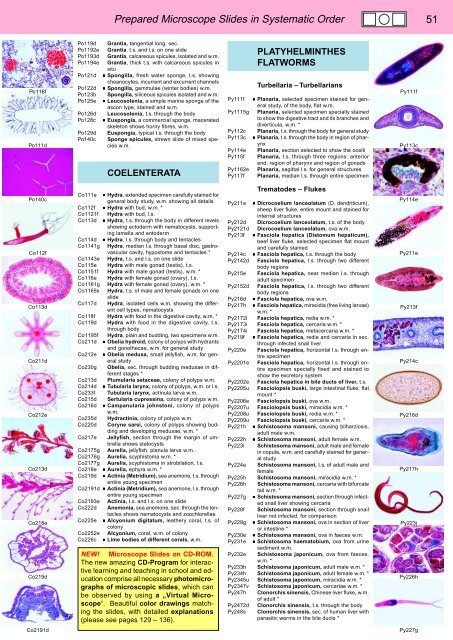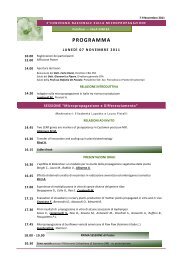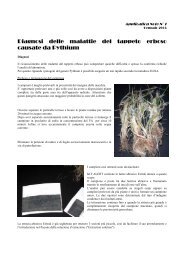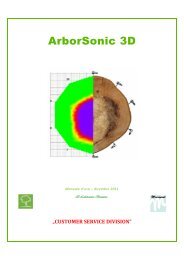BIOLOGY - microscopia.info
BIOLOGY - microscopia.info
BIOLOGY - microscopia.info
You also want an ePaper? Increase the reach of your titles
YUMPU automatically turns print PDFs into web optimized ePapers that Google loves.
Prepared Microscope Slides in Systematic Order 51<br />
Po116f<br />
Po111d<br />
Po119d<br />
Po1192e<br />
Po1193d<br />
Po1194e<br />
Po121d<br />
Po122d<br />
Po123b<br />
Po125e<br />
Po126d<br />
Po128c<br />
Po129d<br />
Po140c<br />
Grantia, tangential long. sec.<br />
Grantia. t.s. and l.s. on one slide<br />
Grantia, calcareous spicules, isolated and w.m.<br />
Grantia, thick t.s. with calcareous spicules in<br />
situ<br />
• Spongilla, fresh water sponge, t.s. showing<br />
choanocytes, incurrent and excurrent channels<br />
• Spongilla, gemmulae (winter bodies) w.m.<br />
Spongilla, siliceous spicules isolated and w.m.<br />
• Leucosolenia, a simple marine sponge of the<br />
ascon type, stained and w.m.<br />
Leucosolenia, t.s. through the body<br />
• Euspongia, a commercial sponge, macerated<br />
skeleton shows horny fibres, w.m.<br />
Euspongia, typical t.s. through the body<br />
Sponge spicules, strewn slide of mixed species<br />
w.m.<br />
COELENTERATA<br />
Py111f<br />
Py1115g<br />
Py112c<br />
Py113c<br />
Py114e<br />
Py115f<br />
Py1162e<br />
Py117f<br />
PLATYHELMINTHES<br />
FLATWORMS<br />
Turbellaria – Turbellarians<br />
• Planaria, selected specimen stained for general<br />
study, of the body, flat w.m.<br />
Planaria, selected specimen specially stained<br />
to show the digestive tract and its branches and<br />
diverticula, w.m. *<br />
Planaria, t.s. through the body for general study<br />
• Planaria, t.s. through the body in region of pharynx<br />
Planaria, section selected to show the ocelli<br />
Planaria, t.s. through three regions: anterior<br />
end, region of pharynx and region of gonads<br />
Planaria, sagittal l.s. for general structures<br />
Planaria, median l.s. through entire specimen<br />
Py111f<br />
Py113c<br />
Po140c<br />
Co112f<br />
Co113d<br />
Co211d<br />
Co212e<br />
Co213d<br />
Co218e<br />
Co219d<br />
Co111e • Hydra, extended specimen carefully stained for<br />
general body study, w.m. showing all details<br />
Co112f • Hydra with bud, w.m. *<br />
Co1121f Hydra with bud, l.s.<br />
Co113d • Hydra, t.s. through the body in different levels<br />
showing ectoderm with nematocysts, supporting<br />
lamella and entoderm<br />
Co114d • Hydra, l.s. through body and tentacles<br />
Co1141g Hydra, median l.s. through basal disc, gastrovascular<br />
cavity, hypostome and tentacles *<br />
Co1143e Hydra, t.s. and l.s. on one slide<br />
Co115e Hydra with male gonad (testis), t.s.<br />
Co1151f Hydra with male gonad (testis), w.m. *<br />
Co116e Hydra with female gonad (ovary), t.s.<br />
Co1161g Hydra with female gonad (ovary), w.m. *<br />
Co1165s Hydra, t.s. of male and female gonads on one<br />
slide<br />
Co117d Hydra, isolated cells w.m. showing the different<br />
cell types, nematocysts<br />
Co118f Hydra with food in the digestive cavity, w.m. *<br />
Co119d Hydra with food in the digestive cavity, t.s.<br />
through body<br />
Co1195f Hydra, plain and budding, two specimens w.m.<br />
Co211d • Obelia hydroid, colony of polyps with hydrants<br />
and gonothecae, w.m. for general study<br />
Co212e • Obelia medusa, small jellyfish, w.m. for general<br />
study<br />
Co230g Obelia, sec. through budding medusae in different<br />
stages *<br />
Co213d Plumularia setaceae, colony of polyps w.m.<br />
Co214d • Tubularia larynx, colony of polyps, w.m. or l.s.<br />
Co233f Tubularia larynx, actinula larva w.m.<br />
Co215d Sertularia cupressina, colony of polyps w.m.<br />
Co216d • Campanularia johnstoni, colony of polyps<br />
w.m.<br />
Co235d Hydractinia, colony of polyps w.m.<br />
Co220d Coryne sarsi, colony of polyps showing budding<br />
and developing medusae, w.m. *<br />
Co217e Jellyfish, section through the margin of umbrella<br />
shows statocysts<br />
Co2175g Aurelia, jellyfish, planula larva w.m..<br />
Co2176g Aurelia, scyphistoma w.m. *<br />
Co2177g Aurelia, scyphistoma in strobilation, l.s.<br />
Co218e • Aurelia, ephyra w.m. *<br />
Co219d • Actinia (Metridium), sea anemone, t.s. through<br />
entire young specimen<br />
Co2191d • Actinia (Metridium), sea anemone, l.s. through<br />
entire young specimen<br />
Co2193e Actinia, t.s. and l.s. on one slide<br />
Co222d Anemonia, sea anemone, sec. through the tentacles<br />
shows nematocysts and zoochlorellae<br />
Co225e • Alcyonium digitatum, leathery coral, t.s. of<br />
colony<br />
Co2252e Alcyonium, coral, w.m. of colony<br />
Co226c • Lime bodies of different corals, w.m.<br />
NEW! Microscope Slides on CD-ROM.<br />
The new amazing CD-Program for interactive<br />
learning and teaching in school and education<br />
comprise all necessary photomicrographs<br />
of microscopic slides, which can<br />
be observed by using a „Virtual Microscope“.<br />
Beautiful color drawings matching<br />
the slides, with detailed explanations<br />
(please see pages 129 – 136).<br />
Trematodes – Flukes<br />
Py211e • Dicrocoelium lanceolatum (D. dendriticum),<br />
sheep liver fluke, entire mount and stained for<br />
internal structures<br />
Py212d Dicrocoelium lanceolatum, t.s. of the body<br />
Py2121d Dicrocoelium lanceolatum, ova w.m.<br />
Py213f • Fasciola hepatica (Distomum hepaticum),<br />
beef liver fluke, selected specimen flat mount<br />
and carefully stained<br />
Py214c • Fasciola hepatica, t.s. through the body<br />
Py2142d Fasciola hepatica, t.s. through two different<br />
body regions<br />
Py215e Fasciola hepatica, near median l.s. through<br />
adult specimen<br />
Py2152d Fasciola hepatica, l.s. through two different<br />
body regions<br />
Py216d • Fasciola hepatica, ova w.m.<br />
Py217h • Fasciola hepatica, miracidia (free living larvae)<br />
w.m. *<br />
Py2172i Fasciola hepatica, redia w.m. *<br />
Py2173i Fasciola hepatica, cercaria w.m. *<br />
Py2174i Fasciola hepatica, metacercaria w.m. *<br />
Py219f • Fasciola hepatica, redia and cercaria in sec.<br />
through infected snail liver<br />
Py220e Fasciola hepatica, horizontal l.s. through entire<br />
specimen<br />
Py2201e Fasciola hepatica, horizontal l.s. through entire<br />
specimen specially fixed and stained to<br />
show the excretory system<br />
Py2202e Fasciola hepatica in bile ducts of liver, t.s.<br />
Py2205u Fasciolopsis buski, large intestinal fluke, flat<br />
mount *<br />
Py2206e Fasciolopsis buski, ova w.m.<br />
Py2207u Fasciolopsis buski, miracidia w.m. *<br />
Py2208u Fasciolopsis buski, redia w.m. *<br />
Py2209u Fasciolopsis buski, cercaria w.m. *<br />
Py221h • Schistosoma mansoni, causing bilharziosis,<br />
adult male w.m.<br />
Py222h • Schistosoma mansoni, adult female w.m.<br />
Py223i Schistosoma mansoni, adult male and female<br />
in copula, w.m. and carefully stained for general<br />
study<br />
Py224e Schistosoma mansoni, t.s. of adult male and<br />
female<br />
Py225h Schistosoma mansoni, miracidia w.m. *<br />
Py226h Schistosoma mansoni, cercaria with bifurcate<br />
tail w.m. *<br />
Py227g • Schistosoma mansoni, section through infected<br />
snail liver showing cercaria<br />
Py228f Schistosoma mansoni, section through snail<br />
liver not infected, for comparison<br />
Py229g • Schistosoma mansoni, ova in section of liver<br />
or intestine *<br />
Py230e • Schistosoma mansoni, ova in faeces w.m.<br />
Py231e • Schistosoma haematobium, ova from urine<br />
sediment w.m.<br />
Py232e Schistosoma japonicum, ova from faeces,<br />
w.m. *<br />
Py233h Schistosoma japonicum, adult male w.m. *<br />
Py234h Schistosoma japonicum, adult female w.m. *<br />
Py2345u Schistosoma japonicum, miracidia w.m. *<br />
Py2347v Schistosoma japonicum, cercariae w.m. *<br />
Py247h Clonorchis sinensis, Chinese liver fluke, w.m.<br />
of adult *<br />
Py2472d Clonorchis sinensis, t.s. through the body<br />
Py248s Clonorchis sinensis, sec. of human liver with<br />
parasitic worms in the bile ducts *<br />
Py114e<br />
Py211e<br />
Py213f<br />
Py214c<br />
Py216d<br />
Py217h<br />
Py223i<br />
Py226h<br />
Co2191d<br />
Py227g







